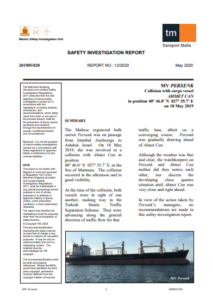Transport Malta MSIU issued an investigation report on the collision of the bulk carrier MV PERSENK with the general cargo ship AHMET CAN, in the Sea of Marmara, in May 2019. The report highlighted that OOWs on both vessels did not notice each other or discern the developing close quarter situation until Ahmet Can was very close and right ahead.
The incident
The Maltese-registered bulk carrier Persenk was on passage from Istanbul Anchorage to Ashdod, Israel.
On 18 May 2019, it collided with Ahmet Can in position 40° 46.0’ N 027° 35.7’ E, in the Sea of Marmara.
The collision occurred in the afternoon and in good visibility.
At the time of the collision, both vessels were in sight of one another, making way in the Turkish Straits Traffic Separation Scheme.
They were advancing along the general direction of traffic flow for that traffic lane, albeit on a converging course.
Persenk was gradually drawing ahead of Ahmet Can.
Although the weather was fine and clear, the watchkeepers on Persenk and Ahmet Can neither did they notice each other, nor discern the developing close quarter situation until Ahmet Can was very close and right ahead.
Conclusions
- The OOWs on both vessels did not notice each other or discern the developing close quarter situation until Ahmet Can was very close and right ahead;
- Neither vessel effectively monitored visual sightings;
- The master’s standing orders to keep a safe navigational watch were not observed;
- The S-band radar was not switched on. The scale on the operational X-band radar was not changed to a suitable range and the sea clutter function was not correctly set;
- ARPA was not used to acquire / track Ahmet Can and the relative visual bearings of were not observed;
- Overtaking of Ahmet Can was not reported to the VTS Centre;
- ECDIS, AIS and other navigational aids were not effectively used and the risk of collision with Ahmet Can was not recognised;
- Ahmet Can’s radar echo masked by the sea clutter / bright patch was not detected;
- It is likely that the OOW was not monitoring the radar display or trying to correlate the target with visual sightings;
- Persenk was sailing outside of the planned XTD limit. No course adjustment was made to set the vessel on the planned track or to the next waypoint;
- The OOW perceived Persenk and Ahmet Can proceeding on parallel course without a clear indication of the CPA or TCPA between the two vessels;
- The OOW did not notice Ahmet Can until immediately before the collision. No action was taken other than calling the master on the bridge;
- The bridge team on Ahmet Can was not keeping a proper look-out astern of the vessel and noticed Persenk only just before the collision;
- Ahmet Can’s sudden manoeuvre to starboard was too late to get out of the way of Persenk.
Actions taken
Persenk’s managers carried out an internal investigation as required by its safety management system requirements.
The company took the following safety actions:
- A Safety Circular on the accident was prepared and distributed fleet-wide, stressing the lessons learned from the situation and reminding the applicable regulations from the SMS, best practice guidelines, COLREGs, seamen’s practice and other organizational safety aspects;
- The details and the conclusions from the Company investigation were included and shared with masters and chief engineers during the shorebased, pre-boarding briefings;
- A plan was made to discuss the accident during the upcoming two sessions of the Company’s three-monthly shore-based ISM seminars for the fleet’s senior officers.
Explore more herebelow:





























































